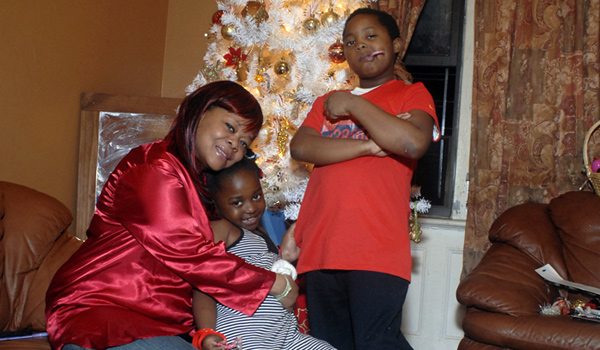ARTS and CULTURE
Kids Who Can't Get Enough of School
Helen Zelon |
One low-income HCZ parent describes how the program has changed her family.

Onilda Acosta posed in her apartment with two of her three children earlier this winter. Acosta’s daughter SaintAngel, 7, and son Dijonne, 11, are both students in Harlem Children’s Zone schools. She says being part of the program has benefited her family.
One low-income HCZ parent describes how the program has changed her family.
A Q&A with Harlem Children’s Zone founder and CEO Geoffrey Canada.
What’s it like teaching inside the school that’s become a national model for community improvement? A Promise Academy instructor explains.
Rather than play a high-stakes game around the U.S. Census in March, immigration activists in New York are poised to play a crucial role in the federal debate on immigration law reform.
A sampling of opinion from the streets of Harlem yields a positive view of the Children’s Zone.
The ‘Promise Neighborhoods’ plan has the policy world abuzz about the first major federal antipoverty effort in decades. But the effort has not yet been launched, and details are hard to come by.
THE MAN OF THE HOURWe will find the money to do this because we can’t afford not to.Geoffrey Canada strides to the lectern in the New York Sheraton’s Grand Metropolitan Ballroom amid the clatter and clink of laden plates and silver coffee urns, as 1,400 sets of eager eyes and ears–fans and acolytes, students and advocates, civic leaders, law enforcement officers, school chiefs, nonprofit staffers and a handful of funders representing 106 communities across the United States–turn their attention away from their sliced-chicken-and-asparagus entrees to the tall, lean man at the front of the room. The diners are gathered at a conference called “Changing the Odds.” They are there because they seek to glean the secrets and wisdom of the Harlem Children’s Zone (HCZ), Canada’s all-encompassing neighborhood anti-poverty program.And they are not alone in listening closely to what Canada has to say. His grand experiment, which began in 1994 as an intensely local web of cradle-to-college social services and has expanded to include two charter schools and 97 square blocks of central Harlem, is about the hottest commodity on today’s national urban-policy scene.Just a few weeks after the conference, Canada was featured in a glowing 60 Minutes portrait—the second time the premier TV newsmagazine has covered the Zone. Oprah Winfrey calls Canada “an angel from God.”
A 10th-grade global studies class. The Children’s Zone’s ultimate goal is to get as many of Harlem’s youth through college as possible. The Promise Academies have yet to graduate a high school class, so it’s not yet known how many will accomplish that feat. Photo by: Alice Proujansky
“If You Hit 65 Percent of the Population, That’s the Tipping Point.” By: Helen Zelon
At the Sheraton conference—co-sponsored by the Harlem Children’s Zone and PolicyLink, a California-based research and advocacy nonprofit with ties to the Obama administration— Canada drapes a lanky arm across the lectern as he speaks, sliding the mic from its stand, and moves downstage to confide in the audience.
Students in the Harlem Children’s Zone achieve the results they do, Canada says, because they invest more: They invest more actual time in the classroom, with a far longer school day and a school year that begins in September and ends in early August. All Promise Academy students are in school about 60 percent longer than average public school students. Struggling students can spend twice as many hours in school as the average kid—in class and in tutoring or in small-group before- and after-school instruction. HCZ’s corporate and school leaders say they hold each child to high standards and expect teachers to do “whatever it takes” to achieve success. And the charters invest more money per child per year—nearly $19,000 in 2008—than the $14,525 the city spends on children who attend general-education programs in traditional open-enrollment public schools.The financial investment starts well before the first formal day of kindergarten.
The charter school movement has been gathering steady steam since the late 1990s in New York City.